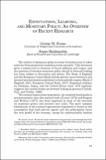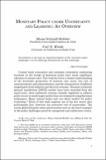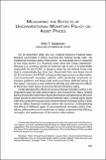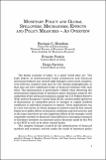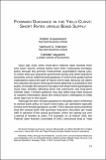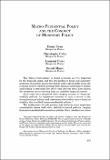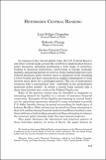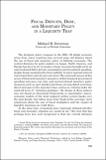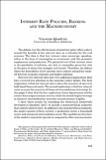Search
Now showing items 1-10 of 18
Expectations, learning and monetary policy: an overview of recent research
The conduct of monetary policy in terms of interest rate or other rules has been extensively studied in recent research. This literature gives a central role to forecasts of future inflation and output, and the question of whether monetary policy should be forward- ooking has been subject to discussion ...
Monetary policy under uncertainty and learning: an overview
Central bank economists and academic economists conducting research on the design of monetary policy have made significant advances in recent years. This work has led to a clearer understanding of the desirable properties of interest rate rules, the role of announcements and communication, and the ...
Measuring the effects of unconventional monetary policy on asset prices
On 16 December 2008 the U.S. Federal Reserve’s Federal Open Market Committee (FOMC) lowered the federal funds rate—its traditional monetary policy instrument—to essentially zero in response to the most severe U.S. financial crisis since the Great Depression. Because U.S. currency carries an interest ...
Monetary policy and global spillovers: mechanisms effects and policy measures: an overview
The global economy of today 'is a small world after all.' The high degree of international trade integration and financial interconnectedness has created tight linkages across most countries even between countries that may be very distant geographically or that may not have significant trade or financial ...
Forward guidance in hte yield curve: short rates versis bond supply
Since late 2008 when short-term interest rates reached their zero lower bound central banks have been conducting monetary policy through two primary instruments: quantitative easing (QE) in which they buy long-term government bonds and other long-term securities and so-called forward guidance in which ...
Macro-prudential policy and the conduct of monetary policy
The 'Great Contraction' in global economic activity triggered by the financial crisis and the extraordinary fiscal and monetary measures that public authorities had to undertake in order to put the economy back on track by putting public finances under heavy strains and leading to extremely low ...
Heterodox central banking
In response to the current global crisis the U.S. Federal Reserve and other central banks around the world have implemented diverse policy measures including purchasing a wide range of securities lending to financial institutions intervening in foreign exchange markets and paying interest on reserves. ...
Fiscal deficits debt and monetary policy in a liquidity trap
The dramatic policy response to the 2008-09 global economic crisis from many countries has revived some old debates about the use of fiscal and monetary policy in fighting recessions. The central dilemma for policy-makers in Japan North America and Europe has been to try to counter a large recession ...
Interest rate policies banking and the macroeconomy
The debate over the effectiveness of monetary policy often centers around the benefits of low interest rates as a stimulus for the real economy. The idea is that low interest rates encourage spending either in the form of consumption or investment and this promotes employment and production. The ...
International aspects of the zero lower bound constraint
Large negative aggregate demand shocks can drive down an economy’s equilibrium real interest rate and if the central bank is committed to stabilizing inflation monetary policy may be hampered by the zero lower bound on nominal interest rates –the economy may be in a 'liquidity trap.' The policy dilemma ...

